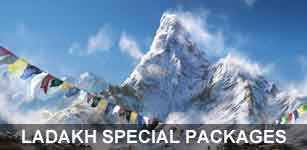Ladakh Religion

The predominant religion in Ladakh is the Tibetan form of Buddhism, although Islamic influences are found from the Kashmir Valley as far as Kargil, and there are some Christian families in Leh.
The Tibetan influence in Ladakh is manifest: all religious books and prayers are in the Tibetan language, the monastic orders in the gompas are those developed in Tibet and the gompa artwork is clearly Tibetan in origin. Even the architectural design of Leh Palace is very similar to that of Lhasa's Potala Palace. Tibetan Buddhism is built on an earlier Tibetan religion - Bon or Bon-Shamanism - and it incorporated many of Bon's demons and gods. It similarly incorporated many of the gods in the Hindu pantheon, transforming them into Bodhisattavas or different incarnations or manifestations of various personalities.
The walls of Ladakh's gompas are covered with illustrations of the Lord Buddha, his manifestations and followers, and the incorporated Bon and Hindu guardian deities in their various incarnations. It all makes for colourful and varied wall murals in every Ladakh gompa.
The monasteries follow each of the two main sects of Buddhism that developed in Tibet: the Karyu pa or red-hat sect and the Gelug pa or yellow-hat sect. The Dalai Lama, believed to be a reincarnation of the Boddhisattva Avalokitesvara, is the head of the Gelug-pa sect.
The gompas represent the monastic side of Buddhism, or lamaism. The lamaist side of Buddhism, requiring lon tation, contrasts with the everyday practice of Buddhism by Ladakhi lay people.
For Ladakhis, religion is a daily affair with visible rituals that are frequently observed. These include spinning prayer wheels, making pilgrimages to gompas, chortens, mani walls and holy tombs, chanting mantras and reciting prayers in the area of the home set aside as a chapel.

